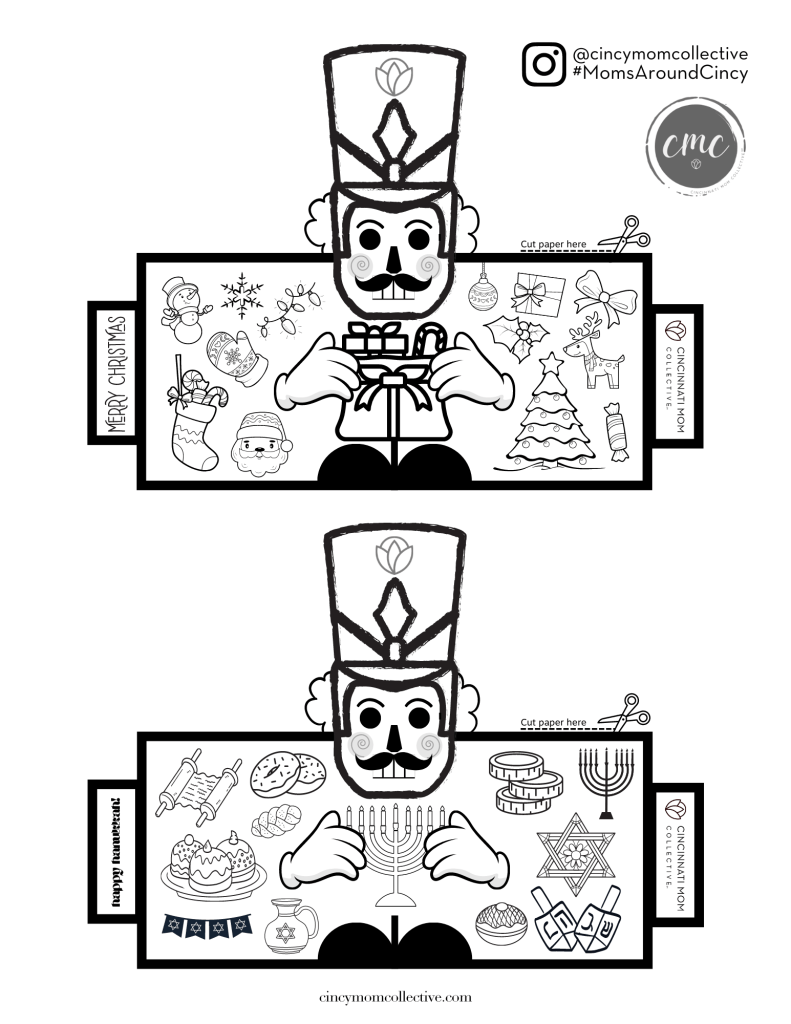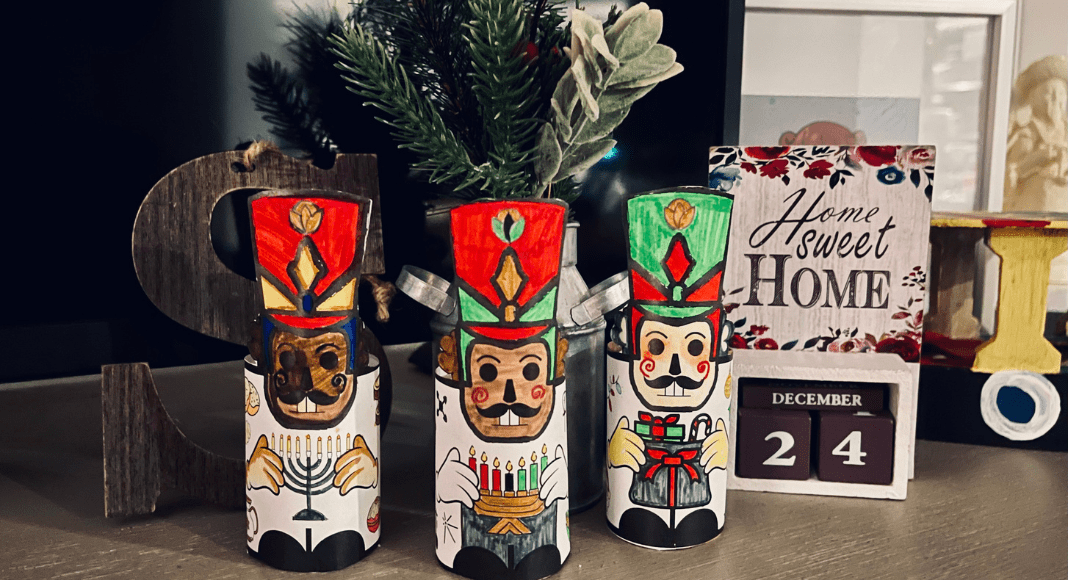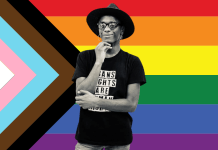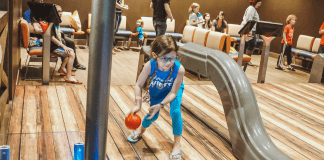
Looking for some fun and simple crafts with the kids this holiday season? If you’re like most households, you use toilet paper… a LOT of toilet paper. Want a way to reuse those TP tubes before throwing them in the recycling bin? Download our FREE printables, and make some December holiday-themed toilet paper tube nutcrackers!
Nutcracker dolls originated from Germany in the late 17th century, primarily from the Ore Mountains (German :: Erzgebirge) region. One origin story says the first nutcracker doll was created by a craftsman from Seiffen. They were often given as gifts to bring good luck and to protect the home, according to German folklore, but were never originally associated with the Christmas season. Nutcrackers are supposed to represent strength and power while they watch over the family, keeping evil spirits and danger away. I have a little bit of German ancestry on my maternal grandmother’s side, and we used to go to a great-aunt’s in upstate New York for Thanksgiving each year when I was growing up. Aunt Sarah always had a ton of Dutch and German trinkets all over her house, and she always had nutcrackers out year-round.
In today’s age, nutcrackers remind us of the holiday season in December and possibly of going to see The Nutcracker performed at the ballet (it does for me!). December is not just about Christmas. The four major holidays celebrated across the world in December are Christmas, Hanukkah, Kwanzaa, and Ōmisoka. In honor of all these holidays, we’ve created printables for each one (along with two generic nutcrackers) that you can color and cut out with the kids, then tape around a toilet paper tube! Voila! You have an awesome decoration, and you may have gotten to learn about a culture or religion you didn’t know much about before!!

CHRISTMAS
I grew up going to Baptist, non-denominational, and Catholic churches, so celebrating Christmas was always a heavy part of my childhood. I have always loved Christmas more than my own birthday… the tradition, the festiveness, the warmth and coziness, the cheer… it fills my heart. Christmas originates from a Christian celebration of the birth of Christ and occurs every year on December 25th. Many of the Christmas traditions began in Germany (like the nutcracker), but Christmas did not start there. It started in Rome around 336 and only became a major Christian festival in the 9th century.
Santa is ingrained in Western Christmas celebrations, but he originates from the Dutch culture and the real St. Nick (Saint Nicholas). The shortened form of the Dutch Sint Nikolaas is Sinter Klaas, which is how the name Santa Claus evolved! St. Nick was once the most popular saint in Europe and was always especially beloved in Holland. Dutch Americans brought Santa into popularity here in the late 18th century. On my maternal great-grandmother’s side, I have Dutch royalty that left Europe and came to America on the Mayflower. When I found this out and then the connection of Santa Claus’ ties to Dutch culture, I was very fascinated. Click the image to download the printable!
HANUKKAH
While doing DNA testing as a family fun project last Summer, I discovered that my partner and I both have Ashkenazi Jew in our ancestry. There was one December as a kid that my mom had us celebrate Hanukkah with a traditional feast and readings and all. It was so different from what we usually did and from what those around us did. I remember thinking it was so cool to learn about another culture and try its food. I had no idea at the time that I had Jewish blood in me. As an adult, I cherish what my mom did that year even more.
Hanukkah is an eight-day Jewish celebration and is often called the Festival of Lights or the Feast of Dedication. Depending on the Hebrew calendar, the holiday can begin in either November or December. It’s celebrated with the lighting of the nine-branched menorah, eating traditional foods, playing games, and giving gifts. “In another allusion to the Hanukkah miracle, traditional Hanukkah foods are fried in oil. Potato pancakes (known as latkes) and jam-filled donuts (sufganiyot) are particularly popular in many Jewish households. Other Hanukkah customs include playing with four-sided spinning tops called dreidels and exchanging gifts. In recent decades, particularly in North America, Hanukkah has exploded into a major commercial phenomenon, largely because it falls near or overlaps with Christmas. From a religious perspective, however, it remains a relatively minor holiday that places no restrictions on working, attending school or other activities,” (History.com Editors, 2009).


KWANZAA
Kwanzaa is a pan-African holiday that began in the 1960s. My partner and daughter have a very high percentage of Nigerian ancestry, so I’ve developed a personal love for African culture and celebrations in the past almost 14 years. Kwanzaa means “first fruits.” The holiday originated to reaffirm and restore African heritage and culture. It is heavily steeped in tradition. “The primary symbols of Kwanzaa are the seven candles (Mishumaa Sabaa), which represent the seven principles (more on that below), the candle holder (Kinara), unity cup (Kikombe cha Umoja), placemat (Mkeka), crops (Mazao), corn (Muhindi), and gifts (Zawadi). All items are displayed on the Mkeka. This serves as a reminder of how African heritage is built upon tradition,” (King, Stephanie L., 2020). Homemade and educational gifts are encouraged, and many people celebrate both Kwanzaa and Christmas.
The Kwanzaa candle colors are black, red, and green. The candles are lit in a certain order one day at a time, and each day highlights a specific principle. The first day honors Umoja or unity. Day two is for Kujichagulia or self-determination. Ujima is on day three and represents the collective work and responsibility for the preservation and development of Black communities. Ujamaa, day four, or cooperative economics urges Black communities to invest in themselves financially. Check out our Black-Owned Businesses Guide and comment with others you’d like us to include! The focus of day five is purpose or Nia. Kuumba is the theme of day six and represents creativity. Kwanzaa is closed out on the seventh day with Imani or faith.
ŌMISOKA
The fourth major holiday celebrated around December in the world comes from Japan, Ōmisoka, which means ringing out the year. “Ōmisoka stands as the final day to bring any unfinished business to a close and prevent the misfortunes of one year from spilling over to the next,” (Nippon.com Staff, 2014). My DNA testing also showed that I have Asian ancestry, but I found out later that I partially come from Chinese descent. I have always loved Asian cultures and foods, and I find this Japanese holiday quite fascinating with a lot of good principles that I can tie into my life and our household.
It is custom that kitchens are given a rest during the first three days. When decorating, it is considered a sin to wait until December 31st. All decorations should be in place no later than December 28th to keep the toshigami, or New Year gods, happy with the proper welcome they demand. Year-end cleaning, or ōsōji, is a way to reflect on the past year and purify the home. Eating bowls of soba on the New Year has been a standard for over two centuries. “Why soba? One explanation says the tradition has its roots in the ease with which the noodles can be bitten through, providing a symbolic “break” from the trials and tribulations of the past year. In addition, the hardiness of the soba plant and length of the noodles are considered to help ensure longevity and health for the diner,” (Nippon.com Staff, 2014). Usually, the holiday is more subdued and ends at a nearby shrine or Buddhist temple with the bell ringing 108 times, representing each of the earthly sins. Then, off to bed!
What holiday do you celebrate with your family around December? More than one? Download your FREE printable, make your own nutcracker, and share with us by tagging us on Instagram and using #MomsAroundCincy!
View this post on Instagram












